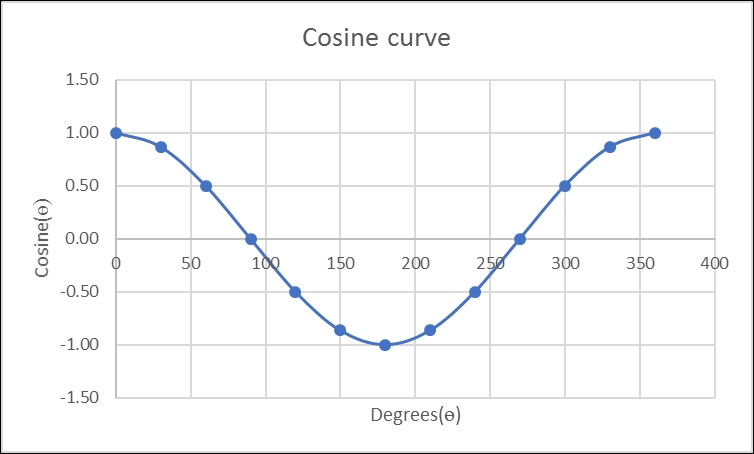The Taylor series formula for the cosine(x) function is as follows:

Write, compile, and run this serial cosine(x) code (see the following code, which shows serial cosine(x) code) to get a feel of the program:
/***********************************
* Serial cosine(x)code. *
* *
* Taylor series representation *
* of the trigonometric cosine(x).*
* *
* Author: Carlos R. Morrison *
* *
* Date: 1/10/2017 *
**********************************/
#include <math.h>
#include <stdio.h>
int main(void)
{
unsigned int j;
unsigned long int k;
long long int B,D;
int num_loops = 17;
float y;
double x;
double sum0=0,A,C,E;
/******************************************************/
printf("
");
printf("Enter angle(deg.):
");
printf("
");
scanf("%f",&y);
if(y <= 180.0)
{
x = y*(M_PI/180.0);
}
else
x = -(360.0-y)*(M_PI/180.0);
/******************************************************/
sum0 = 0;
for(k = 0; k < num_loops; k++)
{
A = (double)pow(-1,k);// (-1^k)
B = 2*k;
C = (double)pow(x,B);// x^2k
D = 1;
for(j=1; j <= B; j++)// (2k!)
{
D *= j;
}
E = (A*C)/(double)D;
sum0 += E;
}
printf("
");
printf(" %.1f deg. = %.3f rads
", y, x);
printf("Cosine(%.1f) = %.4f
", y, sum0);
return 0;
}
Next, write, compile, and run the MPI version of the preceding serial cosine(x) code (see MPI cosine(x) code below), using one processor from each of the 16 nodes.
/**********************************
* MPI cosine(x) code. *
* *
* Taylor series representation *
* of the trigonometric cosine(x).*
* *
* Author: Carlos R. Morrison *
* *
* Date: 1/10/2017 *
**********************************/
#include<mpi.h>// (Open)MPI library
#include<math.h>// math library
#include<stdio.h>// Standard Input/Output library
int main(int argc, char*argv[])
{
long long int total_iter,B,D;
int n = 17,rank,length,numprocs,i,j;
unsigned long int k;
double sum,sum0,rank_integral,A,C,E;
float y,x;
char hostname[MPI_MAX_PROCESSOR_NAME];
MPI_Init(&argc, &argv); // initiates MPI
MPI_Comm_size(MPI_COMM_WORLD, &numprocs); // acquire number of processes
MPI_Comm_rank(MPI_COMM_WORLD, &rank); // acquire current process id
MPI_Get_processor_name(hostname, &length); // acquire hostname
if (rank == 0)
{
printf("
");
printf("#######################################################");
printf("
");
printf("*** Number of processes: %d
",numprocs);
printf("*** processing capacity: %.1f GHz.
",numprocs*1.2);
printf("
");
printf("Master node name: %s
", hostname);
printf("
");
printf("Enter angle(deg.):
");
printf("
");
scanf("%f",&y);
if(y <= 180.0)
{
x = y*(M_PI/180.0);
}
else
x = -(360.0-y)*(M_PI/180.0);
}
// broadcast to all processes, the number of segments you want
MPI_Bcast(&n, 1, MPI_INT, 0, MPI_COMM_WORLD);
MPI_Bcast(&x, 1, MPI_INT, 0, MPI_COMM_WORLD);
// this loop increments the maximum number of iterations, thus providing
// additional work for testing computational speed of the processors
//for(total_iter = 1; total_iter < n; total_iter++)
{
sum0 = 0.0;
// for(i = rank + 1; i <= total_iter; i += numprocs)
for(i = rank + 1; i <= n; i += numprocs)
{
k = (i-1);
A = (double)pow(-1,k);// (-1^k)
B = 2*k;
C = (double)pow(x,B);// x^2k
D = 1;
for(j=1; j <= B; j++)// (2k!)
{
D *= j;
}
E = (A*C)/(double)D;
sum0 += E;
}
rank_integral = sum0;// Partial sum for a given rank
// collect and add the partial sum0 values from all processes
MPI_Reduce(&rank_integral, &sum, 1, MPI_DOUBLE,MPI_SUM, 0,
MPI_COMM_WORLD);
}// End of for(total_iter = 1; total_iter < n; total_iter++)
if(rank == 0)
{
printf("
");
printf(" %.1f deg. = %.3f rads
", y, x);
printf("Cosine(%.3f) = %.3f
", x, sum);
}
// clean up, done with MPI
MPI_Finalize();
return 0;
}// End of int main(int argc, char*argv[])
The following is the MPI cosine(x) run:
alpha@Mst0:/beta/gamma $ time mpiexec -H Mst0,Slv1,Slv2,Slv3,Slv4,Slv5,Slv6,Slv7,Slv8,
Slv9,Slv10,Slv11,Slv12,Slv13,Slv14,Slv15 MPI_cosine
#######################################################
*** Number of processes: 16
*** processing capacity: 19.2 GHz.
Master node name: Mst0
Enter angle(deg.):
0
0.0 deg. = 0.000 rads
Cosine(0.000) = 1.000
real 0m5.309s
user 0m1.280s
sys 0m0.280s
alpha@Mst0:/beta/gamma $ time mpiexec -H Mst0,Slv1,Slv2,Slv3,Slv4,Slv5,Slv6,Slv7,Slv8,
Slv9,Slv10,Slv11,Slv12,Slv13,Slv14,Slv15 MPI_cosine
#######################################################
*** Number of processes: 16
*** processing capacity: 19.2 GHz.
Master node name: Mst0
Enter angle(deg.):
30
30.0 deg. = 0.524 rads
Cosine(0.524) = 0.866
real 0m13.045s
user 0m1.270s
sys 0m0.400s
alpha@Mst0:/beta/gamma $ time mpiexec -H Mst0,Slv1,Slv2,Slv3,Slv4,Slv5,Slv6,Slv7,Slv8,
Slv9,Slv10,Slv11,Slv12,Slv13,Slv14,Slv15 MPI_cosine
#######################################################
*** Number of processes: 16
*** processing capacity: 19.2 GHz.
Master node name: Mst0
Enter angle(deg.):
60
60.0 deg. = 1.047 rads
Cosine(1.047) = 0.500
real 0m18.477s
user 0m1.150s
sys 0m0.450s
alpha@Mst0:/beta/gamma $ time mpiexec -H Mst0,Slv1,Slv2,Slv3,Slv4,Slv5,Slv6,Slv7,Slv8,
Slv9,Slv10,Slv11,Slv12,Slv13,Slv14,Slv15 MPI_cosine
#######################################################
*** Number of processes: 16
*** processing capacity: 19.2 GHz.
Master node name: Mst0
Enter angle(deg.):
90
90.0 deg. = 1.571 rads
Cosine(1.571) = -0.000
real 0m10.567s
user 0m1.240s
sys 0m0.360s
alpha@Mst0:/beta/gamma $ time mpiexec -H Mst0,Slv1,Slv2,Slv3,Slv4,Slv5,Slv6,Slv7,Slv8,
Slv9,Slv10,Slv11,Slv12,Slv13,Slv14,Slv15 MPI_cosine
#######################################################
*** Number of processes: 16
*** processing capacity: 19.2 GHz.
Master node name: Mst0
Enter angle(deg.):
120
120.0 deg. = 2.094 rads
Cosine(2.094) = -0.500
real 0m7.056s
user 0m1.310s
sys 0m0.330s
alpha@Mst0:/beta/gamma $ time mpiexec -H Mst0,Slv1,Slv2,Slv3,Slv4,Slv5,Slv6,Slv7,Slv8,
Slv9,Slv10,Slv11,Slv12,Slv13,Slv14,Slv15 MPI_cosine
#######################################################
*** Number of processes: 16
*** processing capacity: 19.2 GHz.
Master node name: Mst0
Enter angle(deg.):
150
150.0 deg. = 2.618 rads
Cosine(2.618) = -0.866
real 0m8.202s
user 0m1.200s
sys 0m0.390s
alpha@Mst0:/beta/gamma $ time mpiexec -H Mst0,Slv1,Slv2,Slv3,Slv4,Slv5,Slv6,Slv7,Slv8,
Slv9,Slv10,Slv11,Slv12,Slv13,Slv14,Slv15 MPI_cosine
#######################################################
*** Number of processes: 16
*** processing capacity: 19.2 GHz.
Master node name: Mst0
Enter angle(deg.):
180
180.0 deg. = 3.142 rads
Cosine(3.142) = -1.001
real 0m11.139s
user 0m1.250s
sys 0m0.350s
alpha@Mst0:/beta/gamma $ time mpiexec -H Mst0,Slv1,Slv2,Slv3,Slv4,Slv5,Slv6,Slv7,Slv8,
Slv9,Slv10,Slv11,Slv12,Slv13,Slv14,Slv15 MPI_cosine
#######################################################
*** Number of processes: 16
*** processing capacity: 19.2 GHz.
Master node name: Mst0
Enter angle(deg.):
210
210.0 deg. = -2.618 rads
Cosine(-2.618) = -0.866
real 0m6.400s
user 0m1.290s
sys 0m0.330s
alpha@Mst0:/beta/gamma $ time mpiexec -H Mst0,Slv1,Slv2,Slv3,Slv4,Slv5,Slv6,Slv7,Slv8,
Slv9,Slv10,Slv11,Slv12,Slv13,Slv14,Slv15 MPI_cosine
#######################################################
*** Number of processes: 16
*** processing capacity: 19.2 GHz.
Master node name: Mst0
Enter angle(deg.):
240
240.0 deg. = -2.094 rads
Cosine(-2.094) = -0.500
real 0m11.837s
user 0m1.320s
sys 0m0.340s
alpha@Mst0:/beta/gamma $ time mpiexec -H Mst0,Slv1,Slv2,Slv3,Slv4,Slv5,Slv6,Slv7,Slv8,
Slv9,Slv10,Slv11,Slv12,Slv13,Slv14,Slv15 MPI_cosine
#######################################################
*** Number of processes: 16
*** processing capacity: 19.2 GHz.
Master node name: Mst0
Enter angle(deg.):
270
270.0 deg. = -1.571 rads
Cosine(-1.571) = -0.000
real 0m8.228s
user 0m1.200s
sys 0m0.360s
alpha@Mst0:/beta/gamma $ time mpiexec -H Mst0,Slv1,Slv2,Slv3,Slv4,Slv5,Slv6,Slv7,Slv8,
Slv9,Slv10,Slv11,Slv12,Slv13,Slv14,Slv15 MPI_cosine
#######################################################
*** Number of processes: 16
*** processing capacity: 19.2 GHz.
Master node name: Mst0
Enter angle(deg.):
300
300.0 deg. = -1.047 rads
Cosine(-1.047) = 0.500
real 0m7.509s
user 0m1.270s
sys 0m0.350s
alpha@Mst0:/beta/gamma $ time mpiexec -H Mst0,Slv1,Slv2,Slv3,Slv4,Slv5,Slv6,Slv7,Slv8,
Slv9,Slv10,Slv11,Slv12,Slv13,Slv14,Slv15 MPI_cosine
#######################################################
*** Number of processes: 16
*** processing capacity: 19.2 GHz.
Master node name: Mst0
Enter angle(deg.):
330
330.0 deg. = -0.524 rads
Cosine(-0.524) = 0.866
real 0m7.167s
user 0m1.180s
sys 0m0.350s
alpha@Mst0:/beta/gamma $ time mpiexec -H Mst0,Slv1,Slv2,Slv3,Slv4,Slv5,Slv6,Slv7,Slv8,
Slv9,Slv10,Slv11,Slv12,Slv13,Slv14,Slv15 MPI_cosine
#######################################################
*** Number of processes: 16
*** processing capacity: 19.2 GHz.
Master node name: Mst0
Enter angle(deg.):
360
360.0 deg. = -0.000 rads
Cosine(-0.000) = 1.000
real 0m10.469s
user 0m1.250s
sys 0m0.300s
The following figure is a plot of the MPI cosine(x) run:

..................Content has been hidden....................
You can't read the all page of ebook, please click here login for view all page.
